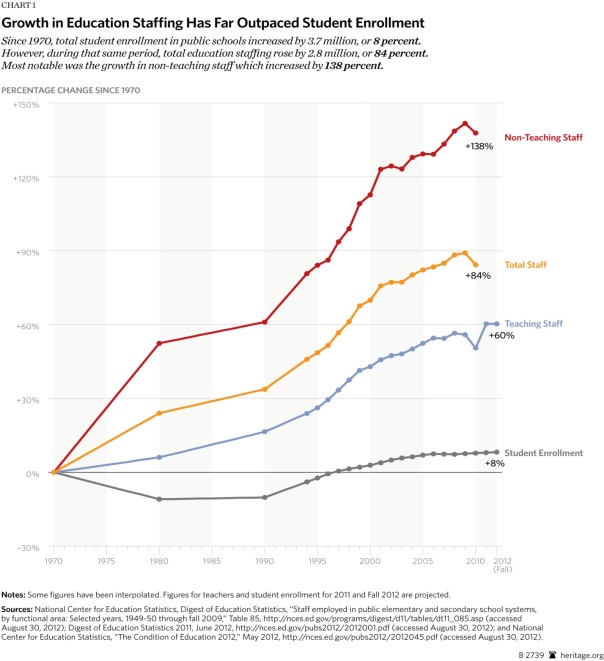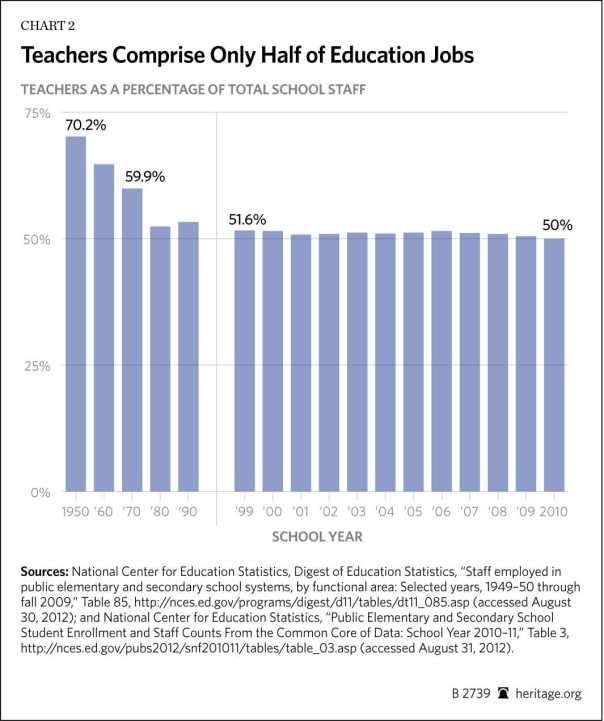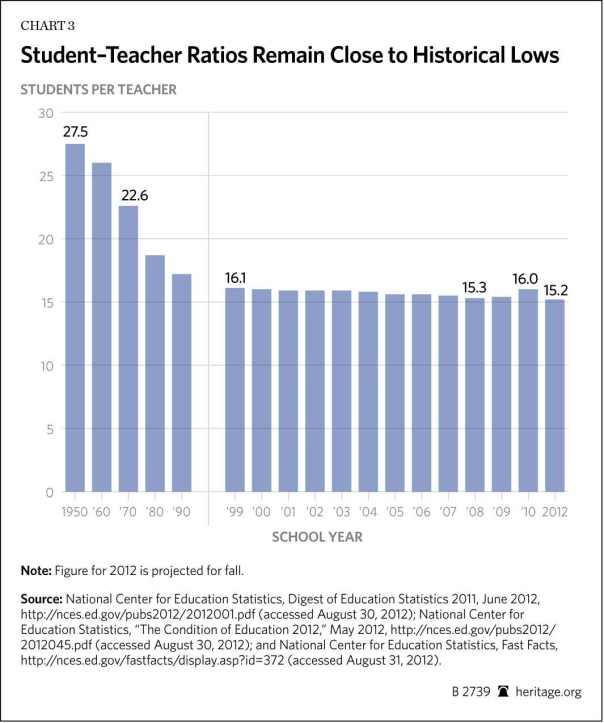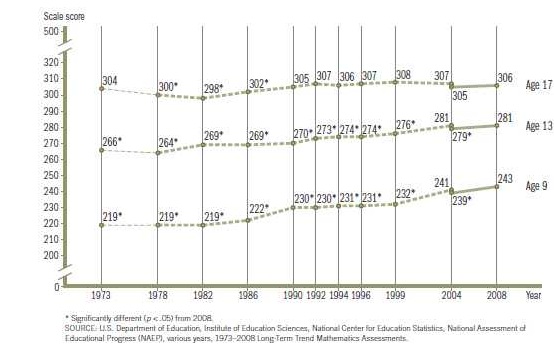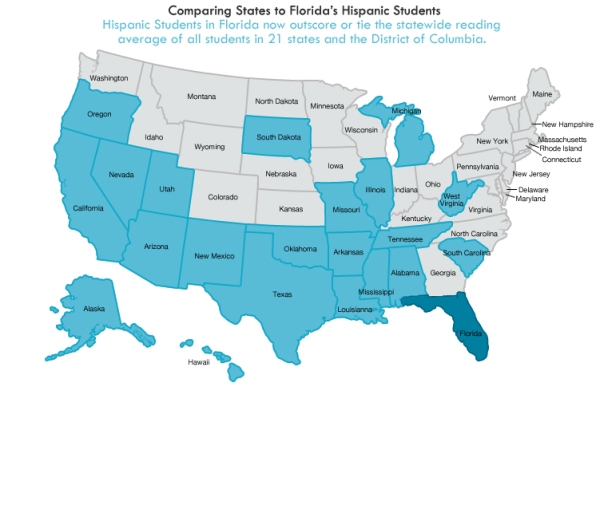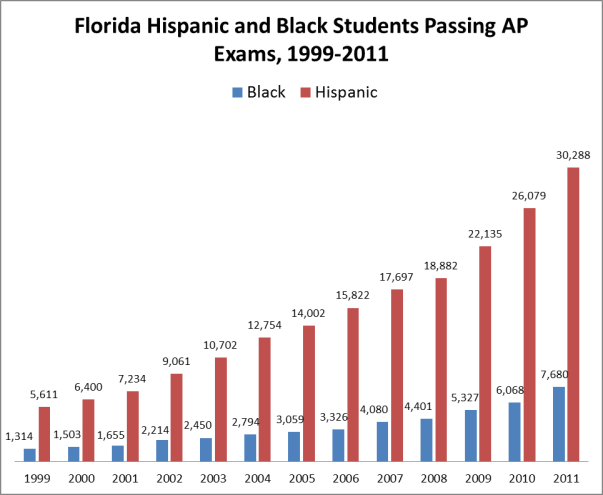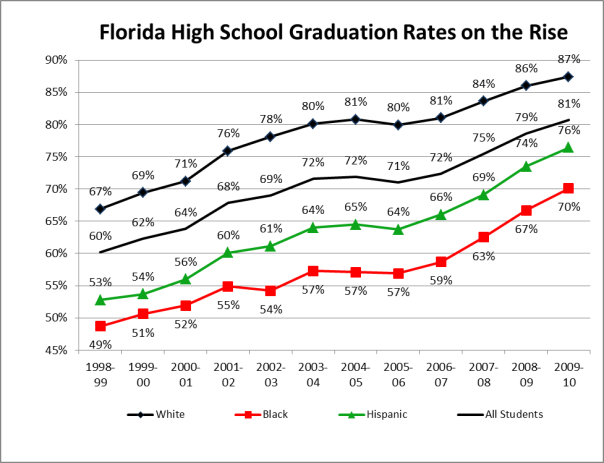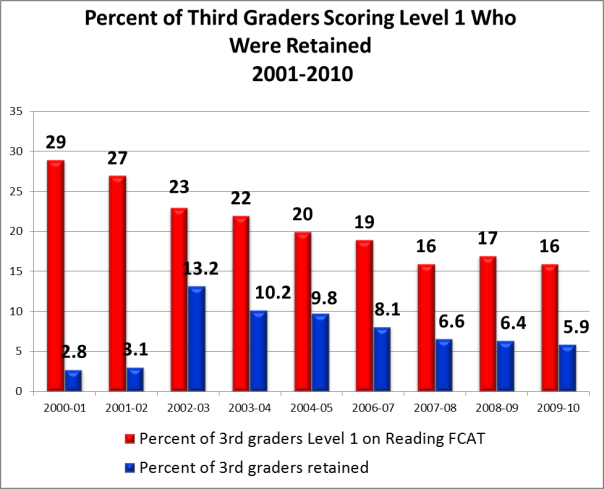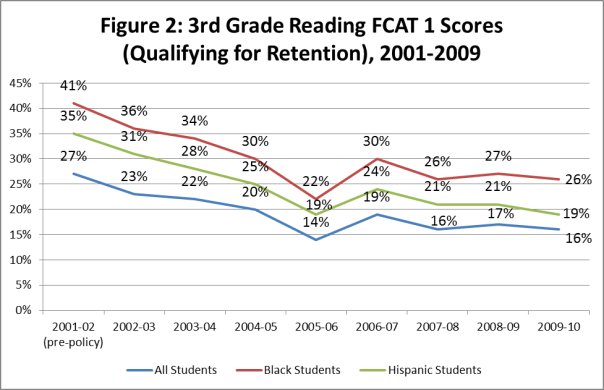By: Dr. Matthew Ladner
So the Heritage Foundation just released these fantastically illustrative charts documenting Baumol’s Disease in American K-12 education. The first shows that total employment in public schools increased by ten times more than enrollment growth, with non-teaching staff leading the way with an incredible 138% increase:
You can’t hire that many non-teachers without the percentage of public school employees being teachers falling off a cliff. Sure enough…
Finally, the stories we continually hear about huge crowded classrooms could only be true if a great many teachers are doing something other than teaching, as the student/teacher ratio is near an all-time low:
And this is what we got in terms of improved academic achievement:
NAEP Long Term Math Scores, 1971-2008
Now is the part of the story where we discuss why this catastrophe happened. It did not happen by accident, nor is it explained in large part by changes in the American student body. Rather it must be understood as a deliberate if perhaps unintentional result of the policy preferences of the most powerful groups influencing public education. No single group bears full responsibility for this catastrophe, and indeed, we all bear some responsibility for it as parents, citizens and taxpayers. Following the advice of Woodward and Bernstein to “follow the money” inevitably leads the finger of accusation to point at the education unions.
You can judge for yourself whether that last statement is fair or not, but before you do, consider exhibit A: Florida. Florida’s education reforms broadly sought to increase the productivity of K-12 spending in a variety of ways:
- The labeling of schools with transparent letter grades was designed to rally community support/pressure for schools in need of improvement and heavily incentivized academic gains among low-achieving students.
- Lawmakers adopted financial incentives for schools to improve their letter grades and to get students to pass Advanced Placement and International Baccalaureate coursework.
- Parental choice programs (charter schools, school vouchers and tuition tax credits) created competitive pressure for public schools to improve.
- The curtailment of social promotion involved the focusing of state and federal funds in the K-3 grades on equipping students with the necessary literacy skills.
These were hardly devastating reforms- Florida public schools have both more students and more students today than they had back in 1999. Stanford University Political Scientist Terry Moe outlines how the Florida Education Association reacted to these reforms on pages 296 and 297 of his book Special Interest (emphasis in the original):
The front-runner in the Democratic primary was Janet Reno, fresh from an eight-year stint as Attorney General in the Clinton administration, and thus a well-known public figure. But the FEA didn’t like Reno as a candidate and took aggressive action to deny her the nomination and install its own candidate as the party’s nominee. Its choice was a man named Bill McBride, who was a complete unknown and had never run for office. Early on, Reno was some 30 points ahead of McBride in the polls. But the FEA sank some $3 million into a blitzkrieg of campaign ads, which eventually had the desired effect. On election-day, McBride won the nomination.
During the general election, the FEA literally ran the McBride campaign. The FEA’s own director of government relations, Cathy Kelly, became the McBride organization’s campaign director, and her salary was paid by the unions. The union’s own communication director, Tony Welch, was also loaned to the McBride organization, and his salary too was paid by the union. Education was McBride’s number one issue, and his agenda-shaped by the FEA-was wholly predictable: he wanted to do away with the A+ accountability system, he wanted to dump the state’s voucher programs, and as “reforms” he favored smaller classes and increases in teacher salaries. Said the St. Petersburg Times, “The union is involved in his campaign at every level, from strategy to communications. Not in recent history has a Florida candidate been so publicly entwined with a single interest group.”
How much the FEA ultimately spent to unseat Bush is unclear, because almost all of its money went into advertising and other independent expenditures that are difficult for anyone to track. But it spent millions. Indeed there were media claims that it had even mortgaged its state headquarters building for more than $1.5 million in order to beef up its available cash.
Skipping ahead a bit…
The lesson, however, is not that the FEA lost, especially to someone of Jeb Bush’s stature. The lesson is that this “weak” state teachers union, which reasonable indicators would suggest is not in the same league with its counterparts in most other states, was nevertheless able to hijack the entire Democratic campaign apparatus in an all-out effort to defeat the nation’s most prominent reformist governor. The FEA wasn’t just another “important interest group.” It took over the Democratic side of the campaign. The election wasn’t really between Bill McBride and Jeb Bush. It was between the Florida Education Association and Jeb Bush.
What was the result of the reforms that the FEA was so desperate to overturn? Well, for starters Florida’s Hispanic students now outscore a whole bunch of statewide averages on the NAEP 4th grade reading exam:
The number of Florida Hispanic and Black students passing Advanced Placement exams increased by more than 500%:
High-school graduation increased from 49% to 70%.
Early childhood illiteracy fell substantially:
Here is a breakdown of early childhood literacy improvement broken down by ethnicity:
So let’s take a moment to sum up…
The Florida Education Association laid down on the proverbial railroad tracks to stop a group of reforms that demonstrably and substantially improved the education outcomes for Florida students. It was a truly awful status-quo to be defending however, and matters have clearly improved. Low-income students, students of color and students with disabilities made especially impressive gains.
Perhaps you might think that an organization with the slightest bit of shame might take a long look in the mirror after delivering such a severe beating to their own reputation and credibility. Perhaps they might quietly or otherwise admit that their fears were misplaced a decade ago, and announce that their views on the desirability of K-12 reform have changed with the times and the availability of evidence.
You might think that, but sadly you are not the FEA leadership. The FEA leadership prefers to hold absurd positions and even express them publicly in the Orlando Sentinel.
Starry-eyed optimist that I am, I would wager everything that Andy Ford and company are decent people who love their mommas and their country, wave the flag proudly on the 4th of July, and root for their sports teams win or lose. Why then would decent people fight to preserve a system with a 49% graduation rate?
Education unions, in the end, are rational actors: they pursue their own interests. The hiring binge in K-12 education (and thus the Baumol’s disease) did not happen on accident, but rather as the result of policies strongly supported by the unions. If it had resulted in internationally competitive K-12 outcomes, groups like ours would not exist. Sadly it failed miserably, and worse still, the reaction from far too many is “steady as she goes!”
Education unions are free to continue to fight to preserve Baumol’s disease at the expense of students and taxpayers. In so doing however they have inflicted enormous harm to their credibility as it is nearly universally recognized that the main victims of K-12’s politically enhanced case of Baumol’s disease are disadvantaged children.
In our next exciting episode, we will discuss K-12 solutions moving forward.
